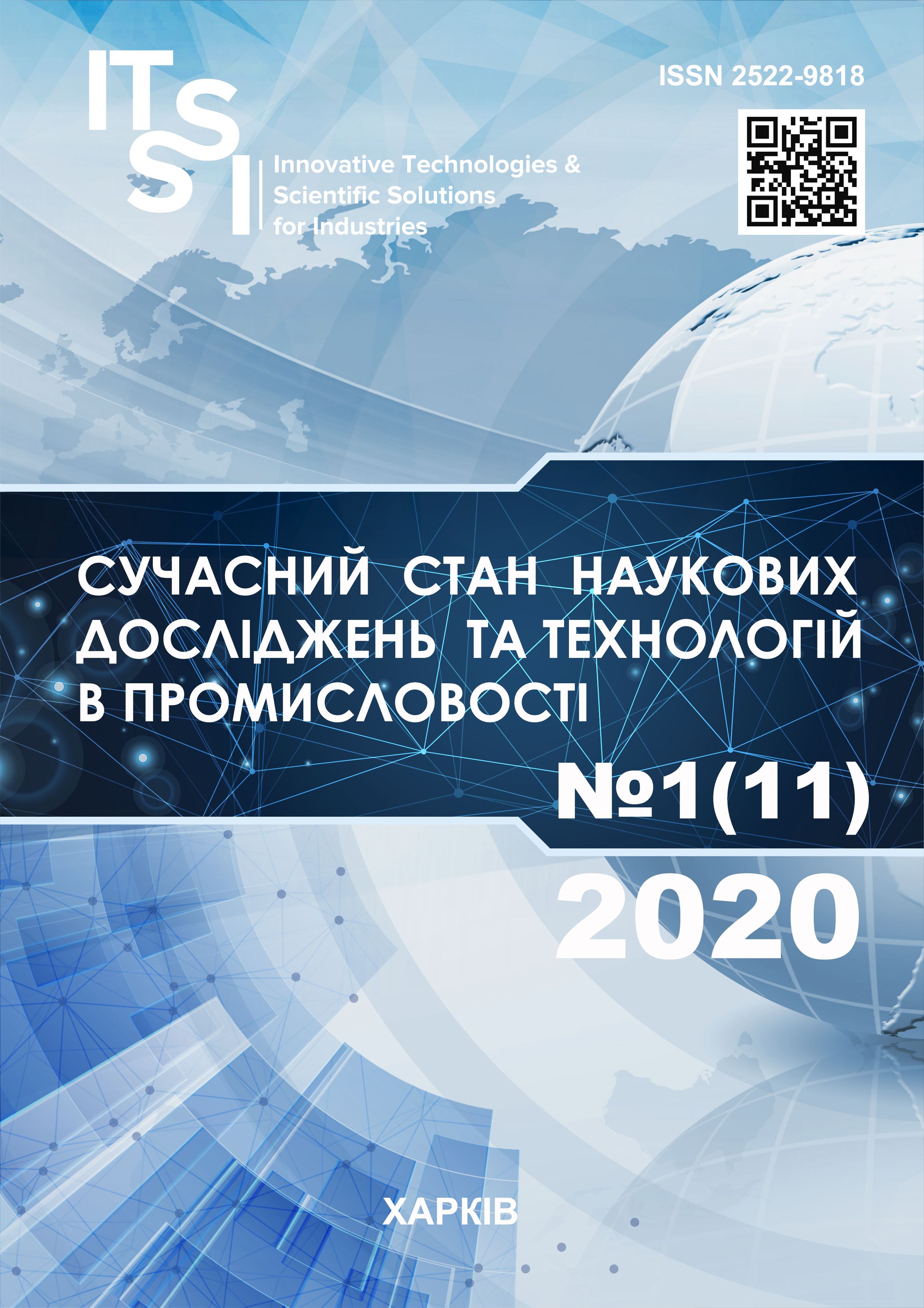DETERMINATION OF THE BASIC PARAMETERS OF SENSOR DEVICES FOR THE IMPLEMENTATION OF PSYCHONEUROLOGICAL RESEARCH WITH THE INTRODUCTION OF MULTITOUCH TECHNOLOGY
DOI:
https://doi.org/10.30837/2522-9818.2020.11.147Keywords:
carpal tunnel syndrome, hand dysfunction, multi-touch devices, dynamic testing, psychoneurologyAbstract
The subject of the article is the testing process on multi-touch devices for the implementation of psychoneurological studies. The goal of the work is development specialized dynamic tests with the introduction of Multi-touch technology to detect carpal tunnel syndrome and hand dysfunction in the early stages of the disease. An objective of the work is to conduct a theoretical analysis to determine the optimal parameters of touchscreen devices for the implementation of psycho neurological testing; based on experimental studies to determine the main physical indicators of the test results, indicating the presence of functional disorders of the hand. The constant use of computers, smartphones, gadgets provide multiple identical load on the wrist; constant visual and neuro-emotional stress; sitting position of the body; static tension of the musculoskeletal system caused by the need to maintain a working posture; decreased overall motor activity. The methods of computer modeling and visualization of dynamic tests using the multi-platform programming language Python were used. Results. The scientific novelty and practical significance of the obtained results is the development of specialized software and algorithmic software for dynamic testing on sensory devices with the ability to video record the movements of the upper extremities in the mode "Rapid". The advantage of this method is its non-invasiveness, ease of implementation, as well as the absence of sensors that can restrict movement. Using the rapid method, one can easily distinguish the pathological state of motor activity of the hand from the established norm. Conclusions. A specialized software tool was developed, which was adapted for multi-touch screens that allow identifying functional disorders of the hand by registering the main physical parameters during testing. Dynamic tests are adapted for any age category of participants (patients), have additional modes for individual color perception and different levels of complexity.
References
Bogov, А. А. et all (2014), "Carpal tunnel syndrome", Practical Medicine, Vol. 4–2, No. 80, P. 35–40.
Aksekili, M. A. (2015), "Comparison of the early postoperative period electrophysiological and clinical findings following carpal tunnel syndrome: is EMG necessary?", Int J Clin Exp Med, Vol. 8, No. 4. P. 6267–6271.
Bland, J. D. P. (2007), "Treatment of carpal tunnel syndrome", Muscle Nerve, Vol. 36, No. 2, P. 167–71.
Blazar, P. E. (2015), "Prognostic indicators for recurrent symptoms after a single corticosteroid injection for carpal tunnel syndrome", J Bone Joint Surg Am, Vol. 97, No. 7, P.1567–1570.
Zaytseva, N. et all (2016), "The diagnostic opportunities of sympathetic skin response in patients with carpal tunnel syndrome", Journal of the Neurological Sciences, Vol. 381, P. 270.
Belova, N. et all (2016), "Autonomic disturbances in CTS", 2nd 108 Congress of the European Academy of Neurology, Copenhagen: Proceedings of theses, P. 117.
Meshchaninov, S. K., Spivak, V. M., Orlov, A. T. (2015), Electronic methods and means of biomedical measurements : a tutorial, K. Chair, 211 p.
Asmakov, S. (2010), "Multiplicity of touch displays", Computer Press, No. 8, P. 60–67.
Mukhin, I. A. (2006), "Touch screens – problem solving", BROADCASTING: Television and Broadcasting, No. 7, P. 64–66.
Bhalla, M. R., Bhalla, A. V. (2010), "Comparative Study of Various Touchscreen Technologies", International Journal of Computer Applications, Vol. 6, No. 8, P. 12–18.
Quinnell, R. A. (1995), Touchscreen Technology, EDN.
Korolchuk, M. S. Kraineuk, V. M. (2006), Socio-psychological support of activity in ordinary and extreme conditions, Kyiv : Nika-Center, 580 p.
By general ed. O. P. Mintzera (2010), Modern methods and means for definition and diagnosis of emotional stress: a monograph, Vinnytsia : National Technical University, 228 p.
Selivanova, K. G. Tymkovych, M. Y., Avrunin, O. G. (2018), "Introduction of multi-touch technology for the implementation of interactive testing in psychoneurology", XVII International Scientific and Technical Conference "Physical Processes and Fields of Technical and Biological Objects": Conference Proceedings, Kremenchuk : KRNU, P. 121–122.
Lebedev, V. V. Selivanova, K. G. (2019), "Application of multi-touch technology for express estimation of stress level of flight composition of aircraft", Proceedings of the reports of the Second All-Ukrainian Scientific and Practical Conference of Young Scientists, Cadets and Students "Aviation, Industry, Society", Kremenchuk, P. 265–266.
Selivanova, K. G. et all (2017), "Computer-aided system for interactive psychomotor testing", Photonics Applications in Astronomy, Communications, Industry, and High Energy Physics Experiments. Proc. of SPIE: Proceedings, Vol. 10445: 104453B. DOI: https://doi.org/10.1117/12.2280815
Selivanova, K. G. et all (2019), "Virtual training system for tremor prevention", Information Technology in Medical Diagnostics II., P. 9–14.
Avrunin, O. G. et all (2015), "The surgical navigation system with optical position determination technology and sources of errors", Journal of Medical Imaging and Health Informatics, No. 5 (4), P. 689–696. DOI: https://doi.org/10.1166/jmihi.2015.1444
Downloads
How to Cite
Issue
Section
License
Copyright (c) 2020 Karina Selivanova, Oleg Avrunin, Nikita Kazimirov

This work is licensed under a Creative Commons Attribution-NonCommercial-ShareAlike 4.0 International License.
Our journal abides by the Creative Commons copyright rights and permissions for open access journals.
Authors who publish with this journal agree to the following terms:
Authors hold the copyright without restrictions and grant the journal right of first publication with the work simultaneously licensed under a Creative Commons Attribution-NonCommercial-ShareAlike 4.0 International License (CC BY-NC-SA 4.0) that allows others to share the work with an acknowledgment of the work's authorship and initial publication in this journal.
Authors are able to enter into separate, additional contractual arrangements for the non-commercial and non-exclusive distribution of the journal's published version of the work (e.g., post it to an institutional repository or publish it in a book), with an acknowledgment of its initial publication in this journal.
Authors are permitted and encouraged to post their published work online (e.g., in institutional repositories or on their website) as it can lead to productive exchanges, as well as earlier and greater citation of published work.














